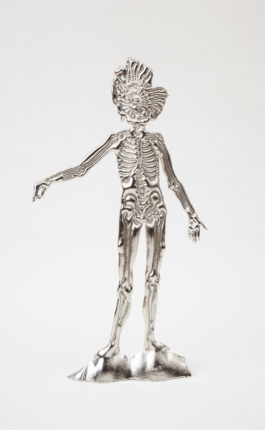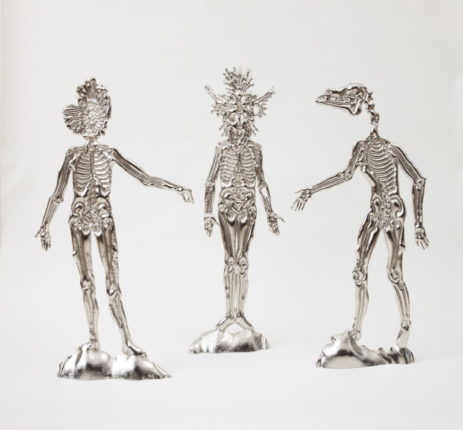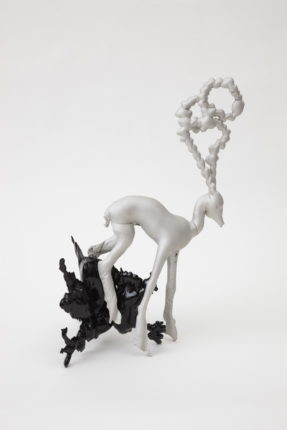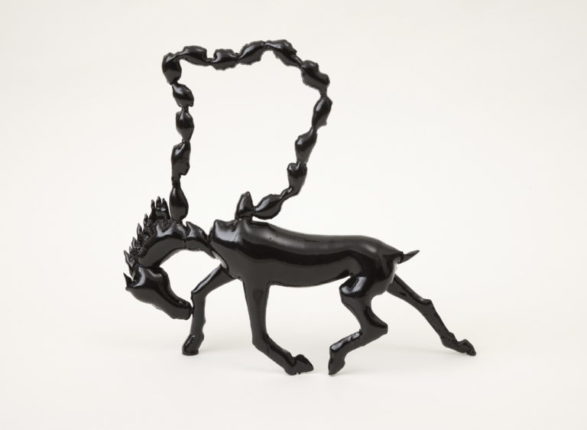Exhibition: 1th1 September to 17th October 2009
Over the past few years Caroline Rothwell has been exploring an imaginary jungle of hybrids and uncanny life-forms. In her studio, she creates new examples of flora and fauna made from vinyl, nickel, bronze, nylon and molten metals. Ranging from the miniature to the monumental, Rothwell’s sculptures, drawings and inflatable installations are new pioneers in the evolutionary chain. In her world, the tropical meets the temperate, the extinct collides with the futuristic, the hunted becomes the heroic, and the ordinary is seen as comic.
“My improbable creatures say more about human psychology than animal biology. My source materials range wide, across such ideas as the representations of ‘otherness’ as portrayed in Victorian natural history museums, mass-produced plastic toys, books on weeds, and the unintended consequences when European voyagers arrived in new lands.”
These ideas result in mutant, poetic forms, creating a kind of ‘nature jamming’ that belies categorization. Her sculpture Puff and Hind (2009), for example, shows a white deer, its antlers twisted into a shape linked with a DNA strand. Clinging to its hind legs is an enlarged, black amoebic form, upsetting the equilibrium of one of Mother Nature’s proud beasts. Meanwhile, Steed (2009) is a prancing black stallion. The back of its neck has been sliced, and droplets of blood form a stylized lasso emerging from its mane.
Slamina (animals backwards) at Maddox Arts also incorporates the human animal into the mix. Some of Rothwell’s skeletal figures are influenced by early European anatomical drawings comparing man to animals. Made from nickel-plated Britannia metal (which shines an almost impossibly bright silver), they are macabre yet comical beings, depicting a horse skeleton, a poppy flower or a massive mouth grafted on to the body of a man.
“Material and process are inherent to Rothwell’s practice,” writes Rome-based art critic Jonathan Turner in the exhibition catalogue. “Rothwell’s sculptures can simultaneously appear to be as light as a feather or as heavy as steel. Her unique production method, whereby molten metal is poured into a cast of stitched fabric, creates an ‘over-stuffed’, voluminous object with skin-like creases. Nickel-plating and powder-coating lend an industrial sheen.”
The sinewy forms of plants are rendered in black PVC in Rothwell’s Lexicon series, which are suspended from the ceiling and draped onto the floor. Rothwell turns this slick, industrial and synthetic material into hand-cut ‘landscape drawings’, in which silhouettes emerge from a lacework of cuts. Fragile and fetishist, the sliced PVC exposes the irregularities caused by trial and error. Scalpel nicks and wavering lines disclose the imperfections of human manufacture.
This exhibition at Maddox Arts in London is concurrent with Rothwell’s show Dispersed at The Economist Plaza in St James, commissioned by the Contemporary Art Society[1]. This features three bronze sculptures of the extinct Tasmanian Tiger based on colonial drawings, museum displays and scientific studies, re-imagined by Rothwell as a cross between a comical soft toy and a nightmarish beast. It is a continuation of her fascination with the concept of the “recreation” of extinct species through genetic manipulation and advances in DNA technology. In the lobby of The Economist, a series of Rothwell’s PVC cut-outs, based on a hybrid group of natural life-forms, climb up the windows to suggest a world enveloped by strange, sub-tropical office plants.
[1] Presented by the Contemporary Art Society, Caroline Rothwell’s Dispersed is showing concurrently on the Economist Plaza.



